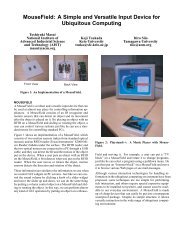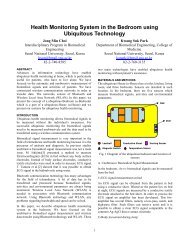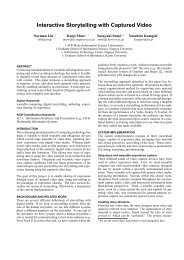Workshops - UbiComp
Workshops - UbiComp
Workshops - UbiComp
- No tags were found...
Create successful ePaper yourself
Turn your PDF publications into a flip-book with our unique Google optimized e-Paper software.
BOXED EGO INSTALLATIONA pair of cameras are aimed towards a small platform on acorner of the exhibition space over which sits a cubic peepshowbox. The holes of the peep-box are in fact the eyepiecesof a live-stereoscope. The separation of the videocameras in real space is set to about ten times the real interoculardistance, so that the viewer will see a ten times scaleddownversion of himself inside an equally miniaturized exhibitionspace (hyperstereo effect). The box appears empty;however, if the observer talks or breathes, the box readilydetects this human prey and traps it in its interior, effectivelytransforming the observer into its own object of observation.Indeed, a dwarfed, truly three-dimensional versionof the observer (peering inside an even smaller box)will slowly materialize (figure 1). Perhaps the main differencebetween Boxed Ego and other works featuring artificialautoscopy (either in the Media Arts or in the field of experimentalpsychology [4]) is that (1) the object/subject is perceivedtruly in 3d, although miniaturized (thus combiningautoscopy with micropsia, which are both phenomena thatcorrelate somehow in the medical literature ; (2) the spectatoris filmed from behind, and without a time delay it becomesimpossible for him to see his own face (this makesthe experience very different from that of a mirror or a cameraon top of a screen, reminding us of Magritte’s famouspainting ’La reproduction Interdite’); (3) there is a limitedform of correlated tactile feedback (the spectator can graspthe box and see himself grasping it, while at the same timefeel the real box his hands); (3) lastly, although not sufficientlycompelling in this experiment, the suggested infiniterecurrence of observer-observers could potentially generatea sense of multiple body relocation (see below).The idea behind this installation was to explore, in an artisticway, the links between curiosity and voyeurism. Whilepeering inside the box, one can see oneself in every detail,and to a certain extent play with one’s own avatar (in particularthanks to some time delay in the video loop). At thesame time, one cannot see the other people in the exhibitionspace (see video in [5]). The installation was exhibited for aweek at SonarMatica Media Art festival in Barcelona (2008)with much success. A commentator later reasoned that thiscould be because ’the theme of self-voyeurism is unsurprisinglyvery popular with the festival goers.’ We agree withthis remark (after all, even a simple mirror always retainssome magic), but the question remains open: why are weso attracted by these devices? Of course there is a practicalaspect to the experience (e.g. tighting your necktie); however,we hypothesize that there is more to this: this sort ofsetup brings us close to an out-of-body experience which isinteresting per se: it give our minds the opportunity to betteritself in the mastery of the sensorimotor contingencies in anunusual territory.THE OUT-OF-BODY EXPERIENCEOut-of-body experiences (OBEs) are a culturally invariantneuropsychological phenomena that can take a variety ofdifferent forms, ranging from seeing one’s own body froman elevated visuospatial perspective (the placement of thestereo cameras in the Boxed Ego installation tries to cap-Figure 1. Stereo pair as displayed inside the box (without optics)ture this) to the less known ’heautoscopic’ hallucination,consisting on perceiving a duplicate of ones body in extrapersonalspace [6]. Although the etiology of the OBEsvaries widely (organic dysfunctions such as epilepsy, sleepparalysis,psychological disorders or traumatic experiencesbut also episodes without a know trigger), direct electricalstimulation of the cortex in pre-operatory brain surgeryfor intractable epilepsy as well as less invasive experiments(trans-cranial electrical or magnetic stimulation [7]) andfMRI performed during paroxystical hallucinations, all pointto the involvement of a very specific area in the brain,namely the temporo-parietal area [6].Complete distal attribution and OBEIt is interesting to note that although classical OBE implywhole visuospatial relocation in space, it is also possible tohave relocated parts of the body. This partial relocation isa relatively common occurrence described in the medicalliterature [9], but also easily reproducible on healthy subjects[10]. It may be argued that ’relocation’ of sensation isa normal way of functioning of the sensory-motor apparatus:for any practical purpose, it must feel like the sensationis precisely located at the site of stimulation (e.g. on the tipof our finger), instead of, say, inside the head. We alwaysfeel located sensations, and in particular located in a part ofthe world that we perceive as ’ours’. Distal attribution isthe technical term for a very common phenomena, that ofsituating the stimulus where the action responsible for it istaking place - even if this part is extracorporeal. That’s whywe feel the texture of paper at the end of the pen, not onyour fingers where the force is actually sensed. Distal attributionis exploited in robotic telexistence systems (the usercan operate the robot on the same room, or be in another continentfor that matter). However, there seems to be a thresholdof sensory immersion and sensory-motor correlation thatwhen reached, transforms the fairly common experience describedas distal attribution into something qualitatively different:it elicits a sense of presence in extracorporeal space.It is therefore tempting to see OBEs as the consequence ofa full body relocation in which the experiencer can still seehis original body (an experience with an entirely differentphenomenology).11






